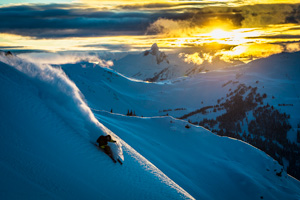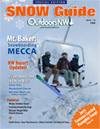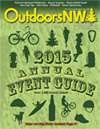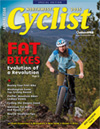Whistler’s Blackcomb Glacier: An Immense Geological Marvel
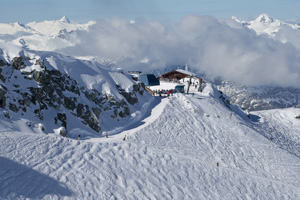
By Mary-Colleen Jenkins
Photo at right: At 7,347 feet, the Blackcomb Glacier is its own tiny, protected provincial park. Photo by Paul Morrison, courtesy of Whistler Blackcomb
It’s easy to be pulled in by the many fun things to do at Whistler, to get caught up in the excitement of resort life. But, the moments that are most memorable, even months after our trip to Whistler and Blackcomb Mountains, are those times when I stopped to truly see what the mountains were all about.
Yes, the beauty of the place is enhanced by well-designed runs and the technical wonder of amenities like the Peak 2 Peak Gondola (the highest lift of its kind in the world), but those are surface details.
What makes Whistler Whistler is geology: volcanos, rocks, ridges, altitude. What makes Whistler Whistler is the effect of the Pacific Ocean on the climate: rainforests, precipitation, temperature. What makes Whistler Whistler includes all of the elements of the natural world we learned about in school—all that science.
Adventure to the Glacier
One of the best places to see that science firsthand is to head over to the Blackcomb Glacier. It takes some effort to get to the entrance, but it is well worth it. At 7,347 feet, the glacier is its own tiny, protected provincial park, adjacent to British Columbia’s massive Garibaldi Provincial Park.
To get there from the village at the base, we had to take a gondola through the “civilized” runs on the lower mountain, ride two express lifts to get above tree line, and then balance on a T-bar for the final assisted slide to the top. But, we weren’t at the glacier yet—at this point we couldn’t even see it. There was still a short hike up to the entrance. And then?
Consider the Immensity
Just when I was about to catch my breath from the hike, it was taken away again by the vista before us. The immense cirque where the glacier originates gradually opens into a bowl so wide that the skiers traversing toward the middle looked like tiny moving insects even though just a few moments before they were regular-sized human beings.
It takes a moment to consider this, to feel the impact of your true size against the immense backdrop of land formations that evolved from forces that we can understand intellectually, but that are suddenly inexplicable when you’re staring right at them.
Many skiers stand here and strategize—there are infinite possibilities for runs on this glacier—I just wanted to gaze at the rocks, the glint of the sun on the snow, the grace of the paragliders floating down the valley, their colorful wings a vivid contrast against blue sky and snow.
Snow, Wind and Sun
There had not been fresh snowfall in Whistler for about a week and morning conditions all over the mountain had been icy, so we had waited until afternoon for our trip to the glacier. Though waiting meant that we could only do one run on Blackcomb Glacier, it was the right decision.
The sun-soaked bowl had softened enough that the snow was fun to ski, but we had to stay flexible—glacial snow is not uniform. As the elevation drops, the snow is affected by different conditions, especially the rate it melts or condenses. Different levels of wind exposure affect it, too.
All of these variables, however, make the experience more fascinating than a typical ski run.
We stopped in one of the rock fields about midway down. The season’s low snow cover left boulders of all sizes exposed—perfect benches for a bit of a rest and a snack. I could have spent all day there, craning my neck to see the ridges surrounding us, the chutes that expert skiers can only dream of accessing.
Happy as a Bird
Eventually, reluctantly, we made our way to the Glacier Road that would take us out of the valley and down to the nearest lift. We paused by the signs at the exit of the valley, gathering momentarily with other skiers who were also dawdling before leaving the glacier behind. Camp jays flew around, looking for crumbs; one settled briefly on the gloves of a smiling skier standing stock still, arms out, happy as a bird herself.
Getting to Blackcomb Glacier from Whistler Village:
Take the Blackcomb Excalibur Gondola to the Excelerator Express Lift. Take the Jersey Cream road to the Glacier Express Lift. Take a brief turn on the Crystal Traverse to the Showcase T-Bar. Hike a few yards to the Blackcomb Glacier entrance.
Mary-Colleen Jenkins is a freelance editor, writing coach and writer of the blog Along the Branches (www.alongthebranches.wordpress.com). She teaches technical writing at the University of Washington. You can find her on Twitter at @EmceeReads

